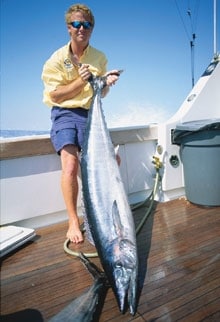
|| |—| || |COOL HEAD: If wahoo are on the prowl, pick up the pace and set an “icer” spread. Photo: George Poveromo| Wahoo fishermen are a notoriously tight-lipped bunch, but recently there was a leak in the ranks. Word got out about a high-speed rig that was fooling big wahoo from South Florida to the Bahamas. I heard about it from Captain Harry Vernon III of Capt. Harry’s Fishing Tackle Supply in Miami. The rig is an in-line, dual-hook, high-speed setup that I call the “icer” because it puts fish in the box when others don’t.
The icer leads off with an in-line trolling sinker, so it tracks exceptionally well at the high speeds that incite wahoo strikes. The rig also keeps fish from shaking free because the hook arrangement and trolling speed combine to hook fish solidly nearly every single time. The best part about the icer is that you can make one yourself in just a few easy steps (see “Ice Sculpting”).
Make Your Own
To rig the icer, I use a Bost No. 38 Rum Cay Pro rockethead with a double skirt, but any trolling lure with a similar tapered, streamlined head will do just fine. For hot colors, Vernon says lures with abalone inserts in greenish or blackish tints are the ticket when wahoo are feeding on houndfish, as they often are along reefs in the Bahamas. Blue-and-white or pink-and-blue seem to do well when flying fish are prevalent. If the forage isn’t apparent, Vernon advises putting out a mixed-color spread to see which lure color gets bit more often than the rest.
The dual-hook arrangement is sold as a single unit with a pair of Mustad 10/0, No. 7732 hooks rigged in line. All parts of the rig are available at Capt. Harry’s [(800) 327-4088; www.captharry.com]. The trailer is crimped to the eye of the lead hook with 980-pound-test cable, and it is all held in place with hard, heavy-duty heat-shrink tube that stands up to strikes from toothy fish.
A one-ounce egg sinker is placed on the leader between the lead hook and the lure headthis is a critical part of the rig. This lead adds a bit of heft, but also keeps the crimp sleeve at the forward end of the hooks from jamming inside the head of the trolling lure, which happens sometimes at high speeds, making the lure spin. The plastic spacer beads often used for this job in other setups sometimes break under the strain.
One important modification is trimming the lure skirt. Ideally, the point of the rear hook should ride 1/4 to 1/2 inch behind the trailing edge of the skirt. Aside from freeing the hook point to stick a wahoo, the short skirt also keeps the point of the trailing hook from catching in the skirt, which would likely affect the way the lure tracks or lookseven preventing a fish from getting hooked. Why trim this skirt and not one on a marlin lure?
Because the speed at which the icer is trolled causes more turbulence, resulting in more of these snags.
The rest of the rig components include a few 3/64 zinc sleeves and six feet or so of 480-pound-test 49-strand cable. I make up a 30- to 50-foot shock leader of 300-pound-test monofilament, crimping a loop on the leading end and swivel at the rear. This runs between the trolling sinker and the lure setup. I also bring Capt. Harry’s wahoo cigar trolling leads in 16- and 32-ounce sizes. These trolling sinkers are cast with a length of 480-pound-test cable running through the center of the lead weight and are less prone to wobbling than trolling sinkers equipped with an eye at each end.
Rigged to Run
The icer is designed for high-speed trolling, so don’t be afraid to goose the throttle when it’s in the water. Many pros drag the icer at 15 knots or more. It’s an ideal setup for trolling to and from the fishing grounds. I find it especially useful on the way back from the Bahamas, when rough seas often prevent a fast run home.
To use the in-line wahoo icer, attach the crimped loop at the leading end of the 32-ounce sinker setup to the swivel on the main line of a bent-butt outfit spooled with 80- to 100-pound monoor a wire-line outfit. Position the lure anywhere from the prop wash to 300 feet back. The icer tracks two to four feet below the surface, depending on speed.
For another option, place the icer in the shotgun: 400 to 600 feet back. Pair it with the 16-ounce trolling sinker and watch the wahoo nail it.
The next time you’re headed offshore, put out a small spread of in-line wahoo icers. You may have a successful day on the water before you even hit the fishing grounds.
Ice Sculpting
Pre-made components make the Icer simple to rig.
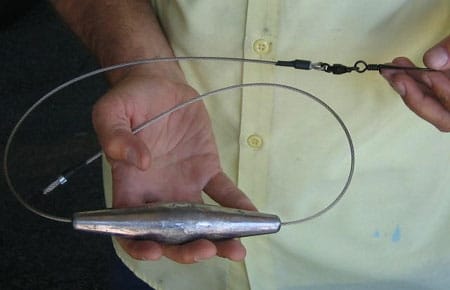
Step 1: Start with a 32- or 48-ounce Capt. Harry’s Wahoo Cigar trolling lead, which is cutom-made with 480-pound-test cable cast through the center of the lead.
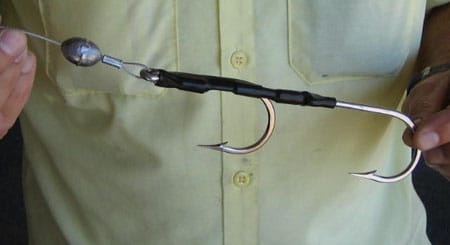
Step 2: Slide an egg sinker and a crimp sleeve onto six feet of 480-pound-test 49-strand cable. Pass the end of the cable through a pre-rigged, two-hook rig and crimp the cable with the sleeve. This two-hook rig consists of two 10/0 hooks connected by crimped 980-pound cable covered with heat-shrink tube.
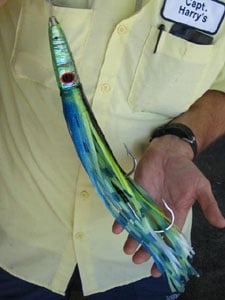
Step 3: Slide a Bost No. 38 Rum Cay Pro rockethead lure onto the other end of the cable leader, and bring it down to the egg sinker.
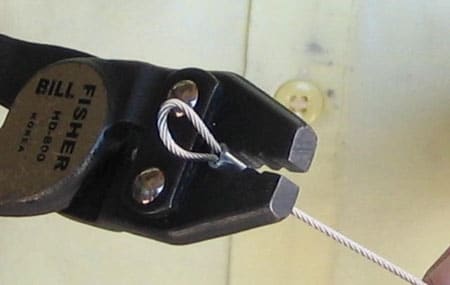
Step 4: Crimp the leading edge of the 480-pound leader.
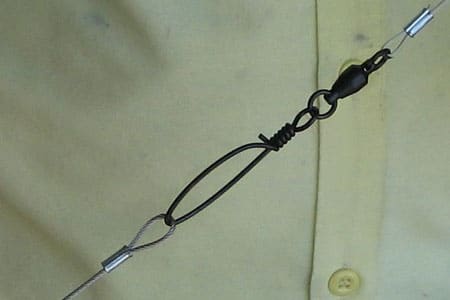
Step 5: Make up a 30- to 50-foot-long shock leader of 300-pound mono with a loop crimped in the leading end and a loop with a 200-pound ball-bearing swivel with a coast-lock snap in the trailing end. Clip this swivel to the leading end of the terminal leader. Attach the leading loop of the 300-pound leader to the trailing-end swivel of the trolling lead.
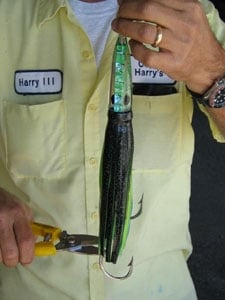
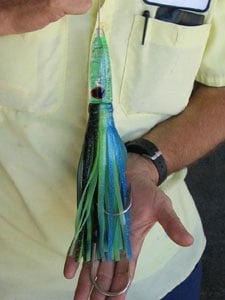
Step 6: (left) Make certain the lure is seated firmly on the egg sinker, then trim the skirt of the lure so the point of the trailing hook sits 1/4 to 1/2 inch behind the trailing edge of the skirt.
Step 7: (right) The short skirt prevents the hook from fouling when the Wahoo Icer is trolled at high speed.









